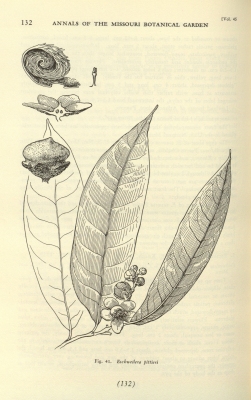Eschweilera reversa
Pittier
Lecythidaceae
This name is not universally accepted. We have followed the treatment in the 'World Checklist of Selected Plant Families', but some other treatments name this taxon as Eschweilera pittieri R.Knuth (treated here as a nom. Illeg., and placed in the synonymy)[
K- Title
- Plants for a Future
- Author
- Ken Fern
- Description
- Notes from observations, tasting etc at Plants For A Future and on field trips.
].
Eschweilera pittieri R.Knuth
Eschweilera verruculosa Pittier
Common Name:
General Information
Eschweilera reversa is an evergreen tree with an elongate to rounded crown; it can grow 10 - 25 metres tall. The straight bole can be up to 80cm in diameter[
333- Title
- Tree Species of Panama
- Publication
-
- Author
-
- Website
- http://ctfs.arnarb.harvard.edu/webatlas/mainframe.php?order=s
- Publisher
-
- Year
- 0
- ISBN
-
- Description
- Factsheets on all the tree and shrub species of Panama, giving identification guide, brief guide to the species and some uses. A vast, but rather incomplete work as of 15/07/09.
,
551- Title
- A Century of Trees of Panama.
- Publication
-
- Author
- Pittier H. Mell C.D.
- Website
- http://www.biodiversitylibrary.org
- Publisher
-
- Year
- 0
- ISBN
-
- Description
- A work that was very difficult to get published according to the correspondence contained at the start!. A treatment of 100 different species with descriptions and details of uses. It can be downloaded from the Internet.
].
The tree is harvested from the wild for local use in craftwork and as a source of fibre and wood.
Known Hazards
None known
Botanical References
Range
S. America - Ecuador, Colombia; C. America - Panama, Costa Rica.
Habitat
Wet or very humid forests at low to medium elevations[
333- Title
- Tree Species of Panama
- Publication
-
- Author
-
- Website
- http://ctfs.arnarb.harvard.edu/webatlas/mainframe.php?order=s
- Publisher
-
- Year
- 0
- ISBN
-
- Description
- Factsheets on all the tree and shrub species of Panama, giving identification guide, brief guide to the species and some uses. A vast, but rather incomplete work as of 15/07/09.
].
Properties
| Other Uses Rating |      |
| Habit | Evergreen Tree |
| Height | 20.00 m |
| Pollinators | Bees, Bats |
| Cultivation Status | Wild |
Cultivation Details
Not known
Edible Uses
None known
Medicinal
None known
Other Uses
Fibres obtained from the bark are used to make rope[
333- Title
- Tree Species of Panama
- Publication
-
- Author
-
- Website
- http://ctfs.arnarb.harvard.edu/webatlas/mainframe.php?order=s
- Publisher
-
- Year
- 0
- ISBN
-
- Description
- Factsheets on all the tree and shrub species of Panama, giving identification guide, brief guide to the species and some uses. A vast, but rather incomplete work as of 15/07/09.
].
The woody fruits are used to make handicrafts[
333- Title
- Tree Species of Panama
- Publication
-
- Author
-
- Website
- http://ctfs.arnarb.harvard.edu/webatlas/mainframe.php?order=s
- Publisher
-
- Year
- 0
- ISBN
-
- Description
- Factsheets on all the tree and shrub species of Panama, giving identification guide, brief guide to the species and some uses. A vast, but rather incomplete work as of 15/07/09.
].
The heartwood is dark brown; the thick band of sapwood is light brown;. The wood is straight and very fine-grained; hard; strong. It takes a high polish. The wood is used in heavy construction, sleepers, floors, cabinet making, joinery etc[
333- Title
- Tree Species of Panama
- Publication
-
- Author
-
- Website
- http://ctfs.arnarb.harvard.edu/webatlas/mainframe.php?order=s
- Publisher
-
- Year
- 0
- ISBN
-
- Description
- Factsheets on all the tree and shrub species of Panama, giving identification guide, brief guide to the species and some uses. A vast, but rather incomplete work as of 15/07/09.
].
We do not have any more specific information for this species, but the general description for the wood of this genus is as follows:-
The heartwood of most species is light brown, grayish-brown, reddish-brown, or brownish-buff, sometimes with black streaks; it is usually distinct from the yellowish sapwood. The texture is fine and uniform; the grain typically straight; lustre is low; there is no distinctive odour or taste. Depending on the species, silica content may be as high as 2.4%. Most species are highly resistant to attack by both brown-rot and white-rot fungi. Also most of the species have gained wide recognition for their high degree of resistance to marine-borer attack. Resistance to dry-wood termite attack is variable, depending on species. The wood is rated as fairly difficult to air season, drying rates are slow to moderate. Warp and checking are rated as slight to moderate, depending on species. Most of the species are difficult to work because of the high density and high silica content (excepting E. tenax); specially tipped cutters are suggested. They can be used for purposes such as marine and other heavy construction, industrial flooring, pulpmill
equipment, railroad crossties, piling, and turnery[
316- Title
- Tropical Timbers of the World. Ag. Handbook No. 607.
- Publication
-
- Author
- Chudnoff. Martin.
- Publisher
- USDA Forest Service. Wisconsin.
- Year
- 1984
- ISBN
-
- Description
- Terse details on the properties of the wood of almost 400 species of trees from the Tropics.
].
Propagation
Seed -
If you have any useful information about this plant, please leave a comment. Comments have to be approved before they are shown here.


 Useful Tropical Plants Database 2014 by
Ken Fern,
web interface by
Ajna Fern
with help from
Richard Morris.
Useful Tropical Plants Database 2014 by
Ken Fern,
web interface by
Ajna Fern
with help from
Richard Morris.